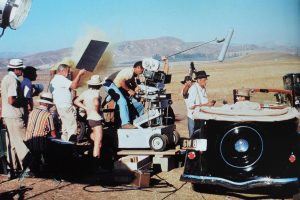A classic of the neo-noir genre directed by Roman Polanski in 1974, Chinatown is a film set in Los Angeles in the 1930’s. Starring Jack Nicholson who plays the role of Jake Gittes, a private detective haunted by the time where he was making his round in Chinatown, he got hired to expose a tawdry affair and finds himself caught in a web of deceit, corruption, and murder. Within dry sceneries, this dark and dizzying investigation reuses the codes of film noir. The cinematography was made by John A. Alonzo (Scarface, Farewell, my Lovely…), and the powerful music orchestrated by a certain Jerry Goldsmith.
A neo-noir thriller
While New Hollywood is booming, Roman Polanski takes the risky bet to revisit the film noir of the 40-50s. Consequently, you can find a typically noir characters, plots, and themes, which tint the film of a pessimistic and a moral ambiguity. Likewise, the movie over uses dramatic low-key lighting, especially in the night shots and with the use shadow cast by the blinds in Gittes’ office. As you’ll read further, the use of symbolism is also very present.
Dryness in the background
Time seems to stretch to the point where we do not know at what time of the day we are or how long has it been. Los Angeles, which is finally seen little, becomes a dehumanized space, avoiding looming cityscapes and rain-soaked streets. This lack of landmarks adds up to the film’s mystery.

Los Angeles’ aesthetic reveals a vast plain parched and burnt by the merciless sunshine. Saturating the subjects, light only makes it harder to discern the truth. John A. Alonzo shoots the city in tones of browns and washed-out yellows, completed by the golden dusk and the black night. This too much sun compels the idea of dryness.
Jake’s bandage
In the first part of the film Jake is wounded in the nose, which will cost him to carry a bandage throughout a major part of the movie. We can see this as a symbol for Jake’s limited heroism. It tends to reveal his human fragility. The scene where he and Evelyn sleep together begins with Evelyn tending his injury, suggesting that this sign of weakness is in fact what makes Jake appealing.
One eye to understand
A symbol we can notice is the powerful images of broken or imperfect lenses, driving the visual structure. Thus, when Jake investigates Mulwray, he uses two watches and when the car runs over one, it breaks. Same thing when he breaks one of Evelyn’s taillights. When he has trouble with farmers, one lens of his sunglasses is broken along with his car’s headlight. As well when he finds the glasses in the pond, one of the lenses has been broken. Again, while Evelyn cleans the cut on his nose, Gittes notices a dark spot in one of her eyes. Afterward, in a tragic ending, the last sign will remain with that killing (no spoiler!) by a bullet in one eye. All these symbols of glasses and eyes, strengthened by other frequent appearances of binoculars, and cameras, represent an attempt to see and understand without the capacity to do so, creating a strong sense of ambiguity and misunderstanding.
Nominated for Best Picture Oscar, the ambitiously depressive aesthetic provided the completely downbeat ending. Even if scriptwriter Robert Towne preferred a close that offered a glimmer of hope, Polanski knew better. Chinatown is a movie that will stay with you forever.














































